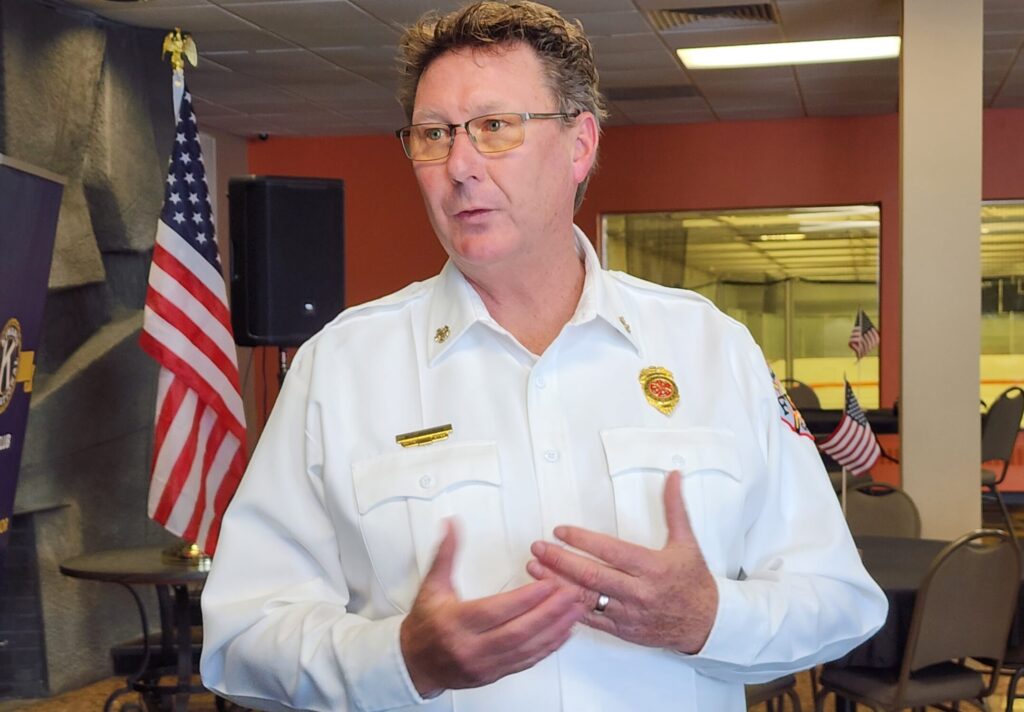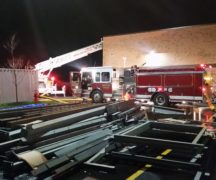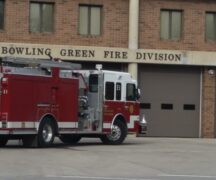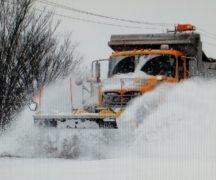By JAN LARSON McLAUGHLIN
BG Independent News
Firefighting is all about the numbers. The minutes that tick by before reaching a fire scene. The number of patients that survive cardiac arrests. The frequency of crews being called to multiple scenes at once. Even the number of cats rescued from trees.
Bowling Green Fire Chief Bill Moorman rattled off the escalating numbers recorded by the city’s fire division, as he presented data Thursday to the BG Kiwanis Club.
“Our call volume is going up and up every year,” Moorman said. “They are going through the roof.”
The data has resulted in changes to reduce response times, shows where the greatest concentration of calls occur, and may lead to a third first station in Bowling Green.
Changes must be “based on data rather than emotion,” the chief said. “Data is everything.”
In 2022, the fire division responded to 3,406 runs – with 76% being EMS runs and 24% being fire runs. The chief can cite the numbers of gas leaks, cardiac arrests, bicycle crashes, hazardous material spills, and bird rescues.
Yes, the fire division has responded to a call about a bird needing to be rescued from a tree in City Park, Moorman said with a grin. Firefighters informed the frantic owner they weren’t in the habit of rescuing birds from trees. But the owner explained it was a $6,000 parrot that had gotten loose from its leash. Firefighters were able to capture the parrot and reunite it with its owner.
“That’s how good we are at BG Fire,” Moorman said with a smile.
Bowling Green Fire Division has achieved high rankings in two meaningful ratings, he said. First, the division is nationally accredited, an achievement only 310 fire departments have reached. That means lower insurance premiums for residents and businesses in Bowling Green.
Second, the fire division is one of only 324 in the U.S. being recognized by the American Heart Association for its success treating patients with cardiac emergencies.
“That means better survivability,” he said.
Moorman talked about the beginnings of fire services in Bowling Green, which in the mid 1800s had several private fire departments that competed against each other. After large downtown fires wiped out large sections of buildings in 1887 and 1888, the city put more emphasis on fire responses.
The number of emergency calls were low – 21 in 1910 – and slow response times could mean devastating outcomes.
It wasn’t until 1971 that the city took over EMS services. Prior to that, local funeral homes responded to medical emergencies, transporting patients in hearses.
In 1984, the fire division moved out of the police station and into its Court Street fire station. In 2000, after concerns about emergency responses being delayed by train traffic, the city opened its second fire station on Pearl Street.
“It all comes down to response times,” Moorman said. “Time is everything. Time is life.”
Today, the fire division has 56 firefighters, including the first three recently hired female firefighters.
Data on the type, locations, and timing of emergency calls has led to changes in recent years. The division used to respond to medical calls with an ambulance staffed by three crew members. Now the division sends an ambulance with two people and a fire truck with three – which offers best survivability chances, Moorman said. It also allows crews to better manage the growing number of obese patients, he added.
“That change has proved itself,” he said.
Once a paramedic is on the scene, it can quickly be determined if the engine crew is needed for a serious medical issue, or if it can return to the station. In several instances, two or more subsequent calls may come in, and the fire truck can quickly respond, Moorman said.
The chief’s goal is for firefighters to respond within six minutes to any call in the city.
“In the fire service, seconds count,” he said. Every second crews can shave off the response time may be vital.
Data from September showed that 79% of calls for fire division help overlapped other emergency calls.
“Sometimes we had five emergency calls at one time,” Moorman said. “The data confirmed what we already knew.”
Heat mapping showed the areas of the city with the most calls for help. The downtown, nursing home facilities, BGSU campus and some apartment complexes glowed due to run demands.
“You can really see the areas that keep up busy,” Moorman said.
The chief also talked about the future of the fire division.
“We always need a plan for the future,” and that’s not just looking six months ahead, but more like 20 to 50 years, he said.
“We need to always ask the question – how can we improve our services to our citizens and visitors in Bowling Green,” Moorman said.
The answer to that may mean the move of the Court Street fire station due to unsafe conditions in the building, and possibly the construction of a third fire station.
“We have to have those very serious conversations,” Moorman said. “We’re always planning for the future. What’s the next emergency coming down the road?”

The Australia native came to Bowling Green Fire Division in 1994 after a long walkabout across the world. He grew up in Mount Beauty, Australia, where kids spent their youths fishing, hunting, mountain biking and “walking out in the bush,” he said. “It was a great place to be a kid.”
It was also a place acquainted with big fires.
“We go from beautiful lush bush to bush fires every 10 years or so,” Moorman said. “We get some big fires in Australia.”
A rite of passage for many teens in Australia involves grabbing a backpack and touring the world before college. Moorman took that to the extreme – spending three years touring 19 countries. He frequently picked up jobs as he traversed the globe.
That experience taught him to understand different cultures – an education as valuable as all the certificates on his wall for skills in dive rescues, fire inspections, cold water rescues, tactical medical response and much more.
His travels eventually landed him in Bowling Green, where he was hired as a firefighter in 1994 and promoted to chief in 2018.
“Thank you for having a lot of faith in me,” he said to Kiwanis member Dick Edwards, who hired Moorman as chief.
The chief also lowered the expectations for his speech.
“I’m more comfortable running into a fire than speaking in front of the group of people,” Moorman confided.





